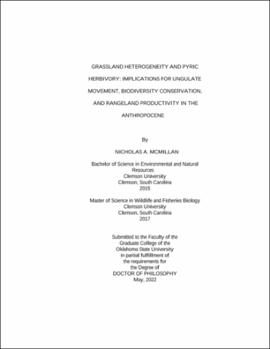| dc.description.abstract | How to simultaneously manage grasslands for sustained livestock productivity and biodiversity conservation is a persistent dilemma for rangeland ecologists and conservationists. Moreover, climate change and invasive species are recognized as potential threats to many grassland management and conservation objectives. Pyric herbivory – the recoupling of fire and grazing – promotes grassland heterogeneity that is critical to meeting biodiversity, livestock, and invasive species objectives. While fire and physical landscape characteristics (i.e., slope, elevation, aspect, etc.) significantly affect ungulate behavior, it remains unknown how their movement changes with the ambient landscape (i.e., weather, diurnal cycles, seasonal rhythms). The feedbacks between ungulate movement and landscape characteristics – particularly those driven by fire – can also have significant effects on plant communities. However, how feedbacks between invasive species, fire timing, and management (e.g., herbicide, or the interactive effects of fire and herbicide) affect plant dynamics and livestock production remains unknown. Extant knowledge is restricted to studies at small scales unrepresentative of large complex grasslands. Therefore we conducted four distinct studies across grasslands managed with pyric herbivory: two addressing how seasonal, diurnal, and meteorological patterns (e.g., temperature) affect bison movement patterns; and two investigating how invasive species and management approaches aimed at their reduction affect livestock productivity and grassland plant assemblages at multiple scales (0.1m2 – >10^6 m2). We found that bison movements change with season and time of day, and are most affected by air temperature compared to other weather parameters. We also determined that invasive species management may not increase livestock production or biodiversity across large grasslands (i.e., >300 ha), and relationships between invasive species abundance and plant diversity changed with scale. Scale is regarded as a central problem in ecology, and therefore managers should be cautious when applying results from small scale studies to large landscapes. Moreover, landscape heterogeneity is well documented as fostering biodiversity maintenance and ecological resiliency. Therefore, heterogeneity – and processes that promote it – will be critical to conserving grassland biodiversity and function throughout the Anthropocene. | |
